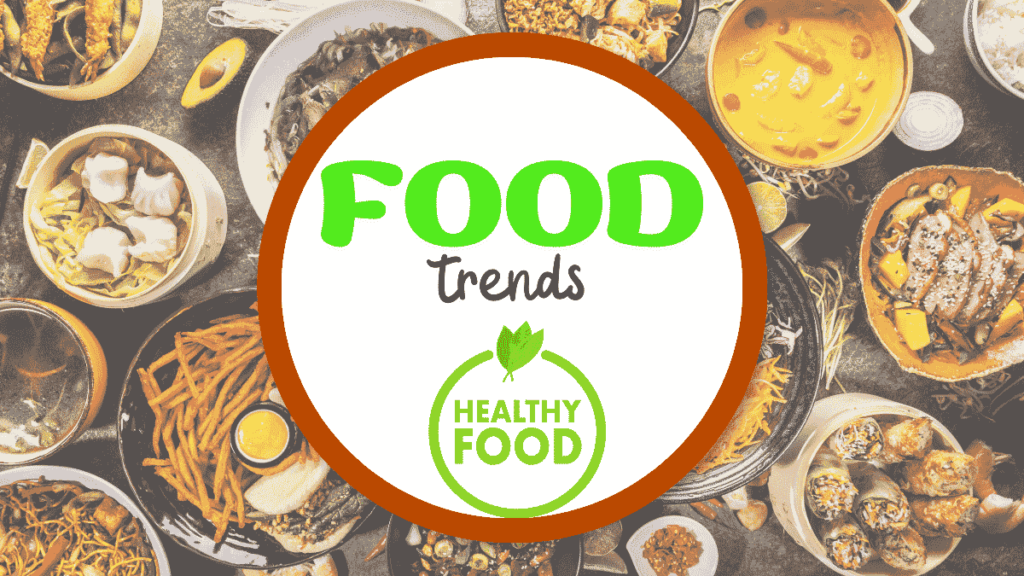Key Takeaways for food trends:
- Lab-grown meat will reach price parity with conventional meat, appearing on more menus globally. This provides a more sustainable protein option.
- AI-powered robot chefs like Flippy will take over commercial kitchens, improving consistency and efficiency.
- 3D food printers will move into restaurants and homes, allowing customized and nutritious meals at the touch of a button.
- Food technology will disrupt the industry from farm to table, making meals faster, healthier, and more sustainable.
Plant-based diets and alternative protein sources
The popularity of plant-based diets is expected to continue to rise in 2024. The global plant-based food market is anticipated to grow considerably, with more young people embracing plant-based foods for their health and the planet. The increasing awareness of the environmental impact of meat production and the health benefits of a plant-based diet drives this trend. As a result, once-steady categories such as meat and breakfast are facing declining demand as consumer tastes change. This shift towards plant-based diets is expected to significantly impact the food industry, with a growing demand for plant-based alternatives to traditional animal-based products.
As plant-based diets continue to gain popularity, there is a growing demand for alternative protein sources. The global alternative protein market size was valued at $4.4 billion in 2020, and this is expected to increase significantly in the coming years. Food tech trends in 2024 are likely to see further investment in lab-created proteins and plant-based alternative proteins, as well as clean-label and functional ingredients that enhance taste and texture in plant-based foods. The increasing awareness of the environmental impact of animal agriculture and the need for sustainable food production drives this shift towards alternative protein sources.
The growth of plant-based diets and alternative protein sources benefits the environment and human health. Plant-based diets have been linked to a reduced risk of chronic diseases such as heart disease, diabetes, and certain types of cancer. Alternative protein sources can also offer health benefits, with some plant-based proteins containing all essential amino acids. Functional foods for gut and mental health are also expected to gain popularity in 2024. By adopting plant-based diets and alternative protein sources, individuals can positively impact the environment and improve their overall health and well-being.
Technology and innovation in food production
Advancements in food technology are set to revolutionize the food industry in 2024. From plant-based meats to lab-grown proteins, innovative food products are gaining traction among consumers who are increasingly interested in sustainable and ethical food choices. In addition to these alternative protein sources, food technology is also improving food safety, shelf life, and nutritional content. For instance, nanotechnology is used to develop more effective food packaging, while gene editing is explored to enhance crop yields and reduce food waste.
Precision agriculture is another significant trend expected to gain momentum in 2024. This approach uses data analytics, sensors, and other technologies to optimize crop yields and reduce environmental impact. Farmers can make more informed decisions about when and how to plant, fertilize, and harvest crops by analyzing soil conditions, weather patterns, and other factors. Precision agriculture can also help reduce the use of pesticides and other harmful chemicals, leading to more sustainable and eco-friendly food production.
Vertical farming and controlled environment agriculture are other emerging trends that offer significant promise for the future of food. These approaches involve growing crops indoors, using artificial lighting, hydroponic systems, and other technologies to create optimal growing conditions. Vertical farming, in particular, can conserve land and natural resources by enabling food production in urban areas. Additionally, controlled environment agriculture can help reduce the environmental impact of food production by minimizing water usage and reducing the need for harmful pesticides and herbicides. As these technologies evolve and become more affordable, they can transform how we grow and consume food, making it more sustainable, efficient, and accessible.
Sustainable food systems and reduced food waste
Sustainable food production will continue to be a significant trend in the food industry in 2024. As consumers become more aware of the environmental impact of food production, there is a growing demand for sustainable and ethical food options. This trend includes a focus on reducing greenhouse gas emissions, water usage, and the use of pesticides and fertilizers. Sustainable food production also promotes biodiversity and supports local farmers and producers. By prioritising sustainable food production, the industry can contribute to a healthier planet and a more resilient food system.
Reducing food waste is another crucial trend in the food industry that will continue to gain momentum in 2024. According to the Food and Agriculture Organization of the United Nations, approximately one-third of all food produced globally is lost or wasted every year. Reducing food waste can help to address food insecurity and reduce the environmental impact of food production. The trend towards circular food systems offers a new approach to reducing waste, emphasizing the importance of using food waste as a resource. This approach involves reducing food waste at the source, redistributing surplus food, and using food waste to create new products, such as compost or biofuels.
Green food processing is another trend that will continue to shape the food industry in 2024. This approach emphasizes using renewable resources, minimizing waste, and reducing energy consumption. Green food processing involves using innovative technologies and practices to reduce the environmental impact of food production, such as using renewable energy sources, reducing water usage, and implementing sustainable packaging solutions. The industry can contribute to a more sustainable and resilient food system by adopting green food processing practices while meeting the growing demand for sustainable and ethical food options.
Personalized nutrition and dietary tracking
One of the biggest food trends of 2024 is personalized nutrition, which involves tailoring an individual’s diet to their unique needs and preferences. This trend is driven by technological advances and data analysis, which allow for more precise and targeted dietary recommendations. Personalized nutrition considers factors such as an individual’s genetics, microbiome, and lifestyle habits to create a customized eating plan that optimizes their health and well-being. This trend particularly appeals to consumers looking for more personalized and effective approaches to nutrition and wellness.
Dietary tracking and monitoring are another trend gaining traction in the food industry. This involves using technology to track and analyze an individual’s food intake, providing valuable insights into their nutritional habits and helping them make more informed choices. With the rise of wearable devices and mobile apps, dietary tracking has become more accessible and convenient. This trend is expected to grow in popularity as consumers become increasingly interested in taking control of their health and wellness.
The focus on personalized nutrition and dietary tracking is driven by a growing interest in the health benefits of food and its potential as a preventative medicine. By optimizing nutrition and tracking dietary habits, individuals can improve their overall health and reduce their risk of developing chronic conditions such as heart disease, diabetes, and obesity. This trend is part of a larger movement towards a more holistic and preventative approach to healthcare, emphasizing the importance of lifestyle factors in maintaining health and preventing disease. As consumers become more aware of the link between nutrition and health, personalized nutrition and dietary tracking will likely become even more popular.
The rise of functional foods and supplements
Functional foods are becoming increasingly popular as consumers seek products offering additional health benefits beyond basic nutrition. These foods are designed to provide specific health benefits, such as improving digestion, boosting immunity, or reducing inflammation. Functional foods can include ingredients such as probiotics, prebiotics, and fibre and fortified foods and beverages that contain added vitamins, minerals, or other nutrients. The global functional foods market is expected to reach $14.62 billion by 2026, with a projected CAGR of 5.8% during the forecast period.
Nutritional supplements are another growth area in the food industry, as consumers increasingly turn to these products to support their health and wellness goals. Supplements can include vitamins, minerals, herbs, and other natural ingredients taken in pill, powder, or liquid form. These products are designed to provide additional nutrients that may be lacking in a person’s diet or to address specific health concerns. The use of supplements is on the rise, with the global health and wellness food market projected to grow at a 5% CAGR, hitting $1.47 trillion in 2027.
A growing interest in health and wellness benefits drives the rise of functional foods and supplements. Consumers are increasingly focused on maintaining optimal health and preventing chronic disease and turning to these products to support their overall well-being. In 2024, we expect to see a continued focus on health and wellness, with a convergence of sustainability and innovation shaping the food industry. From plant-based proteins to lab-grown dairy and innovative fermented foods, the future of food is set to deliver a diverse range of functional and nutritious products.
Changes in food culture and consumer behaviour
One of the significant changes in food culture and preferences we can expect in 2024 is the continued rise of plant-based foods. The trend towards plant-based diets has gained momentum in recent years, driven by a growing awareness of reducing meat consumption’s health and environmental benefits. In 2024, we can expect plant-based options that adapt familiar dishes and food and beverage formats to cater to consumers ready to embrace more plant-based choices. This shift towards plant-based diets reflects a growing desire for sustainable, nutritious, and healthier food options.
Another trend we expect to see in 2024 is an increased interest in local and regional foods. Consumers are becoming more aware of the environmental impact of food production and transportation and seeking locally sourced and produced foods. This trend reflects a growing appreciation for obscure regional ingredients and culinary traditions. By supporting local and regional food systems, consumers can contribute to the food industry’s sustainability while enjoying fresh and flavorful ingredients.
In addition to shifts in food culture and preferences, we can expect changes in consumer behaviour and attitudes towards food in 2024. The rise of the “ultra-processed” food phrase highlights a growing awareness of the negative health impacts of highly processed foods. Consumers are becoming more conscious of their food’s ingredients and seeking natural and minimally processed options. Furthermore, the trend towards eco-conscious dining reflects a growing concern for the environmental impact of food production and waste.
In 2024, we can expect to see more sustainable and climate-conscious food choices, such as reducing food waste, using regenerative agriculture practices, and incorporating alternative protein sources. Overall, the food trends of 2024 reflect a growing awareness and appreciation for sustainable, nutritious, and healthier food options, as well as a desire for more environmentally conscious food production and consumption practices. These trends will shape the food industry in the coming years and offer exciting opportunities for innovation and creativity in the culinary world.
In conclusion, the future of food is set to be shaped by several trends that will transform how we produce, consume, and think about food. Plant-based diets and alternative protein sources will continue to gain momentum due to their environmental and health benefits. Technology and innovation in food production will enable precision agriculture, vertical farming, and controlled environment agriculture to revolutionize the food industry. Sustainable food systems and reduced food waste will become a priority, leading to the adoption of circular food systems.
Personalized nutrition and dietary tracking will become more prevalent, offering health benefits and preventative medicine. The rise of functional foods and supplements will also contribute to health and wellness benefits. Finally, changes in food culture and consumer behaviour will lead to shifts in food preferences, increased interest in local and regional foods, and changes in attitudes towards food. Overall, these trends will shape the future of food and offer new opportunities for the food industry to innovate and meet consumers’ changing needs and demands.
Step into the kitchen of the future. Food technology has advanced rapidly, and 2024 will be a groundbreaking year for new trends that will transform how we think about food. From 3D-printed meals to robot chefs, let us explore the most exciting innovations that will redefine the culinary world.
In the introductory days of 2023, the food tech industry experienced explosive growth. Venture capital investments in food tech startups doubled from the previous year, reaching a record $5 billion. With this influx of funding and talent, many futuristic foods go from lab to table. Read on as we dive into the key trends that will make 2024 a landmark year for food.
Lab-Grown Meat Goes Mainstream
One of the most revolutionary trends is the accelerating adoption of cultured meat. Also known as lab-grown or cell-based meat, this is animal tissue grown from cells without raising and slaughtering animals. In 2021, Singapore approved the first-ever regulatory approval for cell-based meat. Now, in 2024, these products are appearing on more menus and grocery store shelves across the globe. With significant investments from food giants like Tyson and Cargill, the cultivated meat industry is scaling up and increasing affordability. Look for burgers, sausages, and even foie gras grown in bioreactors to become common choices.
AI and Robots Cook Up Disruption
The robots are not just coming… they are already here! AI is revolutionizing commercial kitchens, as robot chefs like Miso Robotics’ Flippy can replicate the talent and skills of human chefs. Cloud-connected and equipped with cameras and sensors, Flippy can grill, fry, and precisely assemble meals. Additionally, AI is augmenting home cooks through apps like SideChef that offer step-by-step guidance. As machine learning algorithms grow more advanced in 2024, expect robots to move from the back to the front of the house. Your next sommelier or sushi chef may be an anthropomorphic robot!
3D Food Printing Gets Delicious
3D printers have moved far beyond plastic trinkets. 3D food printers create nutritious and customized meals on demand as technology improves. Natural Machines’ Foodini, for example, can print pancakes, pizza, and pasta from fresh ingredients loaded into stainless steel capsules. The company partnered with the Spanish government to provide 3D-printed food to older people. As printers grow faster and more affordable, expect fresh 3D-printed meals to appear in cafeterias, restaurants, and vending machines. Parents can print nutritious foods customized to a child’s dietary needs. The possibilities are limitless when cooking moves from art to science.
FAQ:
Q: Is 3D-printed food safe to eat?
A: Yes, 3D food printers combine fresh ingredients and cook in new ways. The foods are nutritious and safe.
Q: Will technology replace human chefs?
A: In commercial kitchens, robots will take over routine cooking tasks, working alongside chefs. However, the creativity and skills of a human chef will still be valued.
Q: When will I be able to buy lab-grown meat?
A: Lab-grown meat is already available in some high-end restaurants. As production scales up, costs will come down, and you’ll start seeing it in grocery stores by 2025 or sooner.
Q: Can home 3D food printers make anything?
A: Current models have some limitations but can make a wide range of foods. As technology evolves, home printers can produce almost any meal imaginable.
The future of food promises to be innovative, sustainable, and delicious. While new technologies rapidly evolve, the human touch will still be vital in the culinary world. One thing is for sure—we’ll look back with wonder at how far food has come when we sit do



